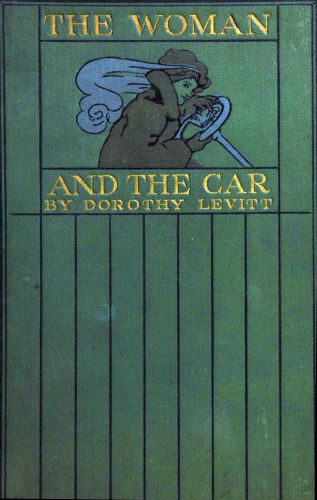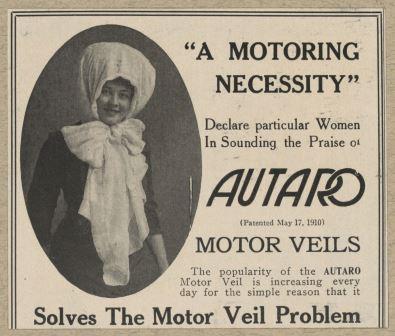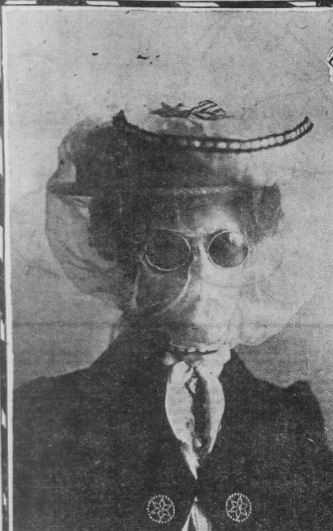I recently gave a presentation on women and the Victorian bicycle craze and explored the way that women’s fashion was examined as the popularity of the bicycle. At the end of the presentation, I touched briefly on the next craze on wheels that hit the public, the automobile. I showed a selection of images from the early 1900s of women in cars and asked the audience the question: “do you think the bicycle craze started a fashion revolution?” In truth, women’s motoring fashions were drastically different from women’s cycling fashions. Here too, function prevailed over fashion, but women’s motoring fashions have maintained slightly less infamy than cycling fashions due to the prevalence of long skirts.
While that may be the case, garments and accessories used for motoring sure were unique for their time.
A look at Edwardian motoring fashions

Smock/overalls/car coat
One of the best resources for studying what Edwardian women wore for an adventure on the road is the 1909 book, Women and the Car by Dorothy Levitt. Written with the same precision as the still-remembered book on bicycling, Bicycling for Ladies, it provides instruction on how to operate a vehicle and manage a solo excursion. And of course, it has an entire chapter dedicated to motoring fashions and how to dress for the road.

According to Levitt, the most crucial garment was a pair of overalls, which I have also seen referred to as a “smock” or “duster coat.” Says Levitt:
“Indispensable to the motoriste who is going to drive her own car is the overall. This should be made of butcher-blue or brown linen, to fasten at the back—the same shape as an artist’s overall. It should have long sleeves. You can always slip off your coat and put on the overall in a moment—and it is necessary if you have anything to do in the car. Remember it is better to get grease-spots on your washable overall than on your coat or other clothes.”
Such coats were relatively simple garments and meant to keep one’s dress clean while motoring. Early automobiles were, after all, wide open on top and driven on dirt roads more often than not. There was also the issue of warmth as anyone who has ridden in a convertible after about August will tell you.
Car coats and overalls ranged in style from the extremely basic, as seen modeled by Levitt below to the more stylish, depending on the final destination of one’s motor ride. In these early days many women took up driving as a hobby similar to cycling, while others enjoyed using automobiles to pay friends visits or attend community events.


And under the car coat? Well, “dress for the season of the year exactly as you would if you were not going motoring” says Levitt.

Motoring hats and motoring veils
Someone who has ridden in many convertibles may also tell you that it is imperative to have one’s hair secured, and even then you may fine that your head gets cold. It is no wonder that motoring veils and hats soon made their way to the market as the automobile gained popularity.
Says Levitt of the proper type of headwear for motoring:
“As to head-gear, there is no question: the round cap or close-fitting turban of fur are the most comfortable and suitable, though with the glass screen up it is possible to wear an ordinary hat, with a veil round it. However, if you go in for caps, see that they fit well—there is nothing more uncomfortable than the cap that does not fit. It is a good plan to have caps made to match your costumes. When fixing the cap, pin it securely, and over it put a crêpe-de-chine veil, of length a-plenty. These can be obtained from most of the leading drapers, and it is quite a simple matter to make them yourself with a length of crêpe or washing silk. Before tying the veil, twist the ends. This prevents the knot working loose and is very necessary, as the veil, in addition to protecting the hair, helps to keep the hat securely in place.”

I find it very interesting that Levitt emphasises the important of long ties and keeping the hat so secure. Losing a hat must have been a looming danger in the early days of the automobile!
Visiting a draper to obtain a veil was one option, but detachable veils to cover the entire face while out in a car were also manufactured and sold.


Motoring googles
And of course, for long, bumpy, open air motor adventures many would have enjoyed wearing the other accessory unique to Edwardian motoring fashions, motoring goggles. Oddly Levitt does not mention goggles in Women and the Car, though we know from the many surviving photographs of her that she did wear them, as did other female hobby motorists.


More motoring tips from Dorothy Levitt
Leave the rings at home
“It is not advisable to wear rings. If you do not want to leave them at home, or in a hotel, but want to wear them when you are indoors, during your ride or tour take them off while on the car and stow them away. Rings, when you are driving yourself, hurt terribly, and also the stones are loosened. Bracelets and bangles are irritating unless secured by a sleeve or glove from working up and down.”
Pack a bit of chocolate for the road!
“This little drawer is the secret of the dainty motoriste. What you put in it depends upon your tastes, but the following articles are what I advise you to have in its recesses. A pair of clean gloves, an extra handkerchief, clean veil, powder-puff (unless you despise them), hair-pins and ordinary pins, a hand mirror—and some chocolates are very soothing, sometimes!”
And for company, bring your pup along
“If you are driving alone a dog is great company. The majority of dogs like motors and soon get into the habit of curling up on the seat by your side, under your coat.”

More women and sports fun:
Madge Syers: breaking the ice on women’s figure skating
How Crazy Was the Bicycle Craze?
Victorian riding habits: more than meets the eye
Three pioneering women’s outdoor clubs that broke all the rules















Leave A Comment